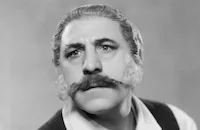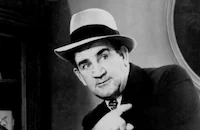Huddle

Brief Synopsis
Cast & Crew
Sam Wood
Ramon Novarro
Madge Evans
Una Merkel
Ralph Graves
John Arledge
Film Details
Technical Specs

Synopsis
Italian-American steel worker Tony Amatto leaves his Gary, Indiana mill job when he gets a $2,000 scholarship to attend Yale. At school, he is reluctant to try out for the freshman football team, thinking it's frivolous, which puts him on the wrong side of the other boys, especially football hero Tom Stone, the son of the owner of the mill in which Tony worked. Tom also dislikes Tony because he thinks that he has insulted his sister Rosalie. During summer vacation, Tony again works at the mill to toughen himself for football, which he now knows will help his career, as well as get him even with Tom. Back at school, Tony helps popular student Jim "Pidge" Pidgeon during a town and gown riot, after which Pidge asks Tony to room with him. On the first day of football practice Tony accidentally breaks Pidge's leg and wants to quit, but Pidge convinces him to continue. Tony becomes a football star, but Tom still doesn't like him and is jealous because his girl friend, Barbara Winston, and Rosalie are both infatuated with him. Tony doesn't really care for Barbara, but she makes a play for him, and he spends a night in her train compartment. An increasingly conceited Tony then goes after Rosalie, who rejects him when he suggests that they spend the night in a private inn. Feeling like a heel, Tony shows up at Mory's Tavern drunk, but his teammates keep him from being seen by Coach Malcolm Gale. The next day, at the Yale-Dartmouth game, a hung-over Tony roughs up a tackler and is taken out of the game, then rushes back onto the field for an important tackle and is sent to the showers by the coach. At the fraternity rush, when Tony is not chosen because of his unsportsmanlike performance at the game, only Pidge stands by him. Tony then goes to the coach to quit, but, after resorting to fisticuffs, Malcolm teaches Tony a lesson about getting along with people and the two become friends. In the spring, Tony asks Rosalie's forgiveness for the way he acted and tells her that he loves her. Rosalie returns his affection, but her father and brother are against their relationship, and Mr. Stone convinces Tony that Rosalie could not live in poverty while he struggles to the top. In Tony's junior year, Malcolm, now impressed by his dedication and hard work, puts Tony in the front line again. The night before the Harvard-Yale game, Rosalie comes to his room and tells him she loves him, and realizes what her father did. She tries to make Tony believe that she doesn't care about money, but he is worried that she will be found in his room and compromised. As she sneaks out, Tom sees her from the back and, thinking she is Barbara, starts a fight with Tony. Tony refuses to compromise anyone and claims that he had been smoking and drinking what was actually consumed by Rosemary. Tony, who has been having stomach pains, goes to see a doctor later and learns that he must have an emergency appendectomy, but he does not want to miss the game and leaves, even though he is warned about a possible burst appendix. Unknown to Tony, his parents come to the game as a surprise. Despite great pain, Tony plays the game, but when he is unable to do well, the coach replaces him. During half-time, Tony puts ice on his stomach in the locker room to deaden the pain, then begs the coach to let him play again. Though feverish and in extreme pain, Tony makes a touchdown, but is sent to the showers by Malcolm who suspects that Tony is ill. Tony hears in the locker room that at the last minute Yale tied the game, and is chastised by Tom, who thinks that Tony was just acting like a prima donna when he left the game, and slaps him. At a post-game party Tony's father tells Pidge that Tony's appendix has burst and he is gravely ill. Pidge then angrily denounces Tom and the others for being snobs, and tells them how much Tony really cares for the school. When Rosemary tells Tom that she was in Tony's room, he wants to apologize, but the coach makes him realize that Tony just wants to be one of the gang. In his senior year, a now recovered Tony is finally popular among the students, and at commencement, his parents sit with Mr. Stone and Rosemary.

Director

Sam Wood
Cast

Ramon Novarro

Madge Evans

Una Merkel
Ralph Graves

John Arledge

Frank Albertson
Kane Richmond
Martha Sleeper

Henry Armetta
Ferike Boros
Rockcliffe Fellows

Joe Sauers

Tom Kennedy
Crew
Adrian
Elbridge Anderson
Crilly Butler
Cedric Gibbons
Arthur S. Hyman
Robert Lee Johnson
Meade Minnigeroode
George S. Pomeroy
Douglas Shearer
Walton Hall Smith
C. Gardner Sullivan
Charles Wallace
John Waters
Harold Wenstrom
Sam Wood
Hugh Wynn

Film Details
Technical Specs

Articles
Huddle
By Richard Harland Smith

Huddle
Quotes
Trivia
Notes
According to pre-production news items in Hollywood Reporter, Robert Z. Leonard had tentatively been set to direct the film and Monte M. Katterjohn was to adapt the novel. Katterjohn was not mentioned in any sources after the film's production and it has not been determined if he did indeed write an adaptation or if any part of it was retained in the released film. A pre-production chart in Hollywood Filmograph credits Robert Shirley with sound, but production charts and Film Daily Year Book only credit Charles Wallace. Another news item in Hollywood Reporter mentioned that M-G-M decided to change the location from Notre Dame, which was the setting of the novel, to Yale, because Universal had recently released the film Spirit of Notre Dame with a similar theme. Some reviews also noted this change. Variety said "Autumn stadium fans will recognize flashes of Albie Booth...and Barry Wood," popular college football players at the time, who appeared in footage of football games incorporated into the film. Some of the incidents of this film were recreated in the 1938 M-G-M British production A Yank at Oxford (see below), although neither the original Wallace novel, nor any of the screenwriters of Huddle were credited.














